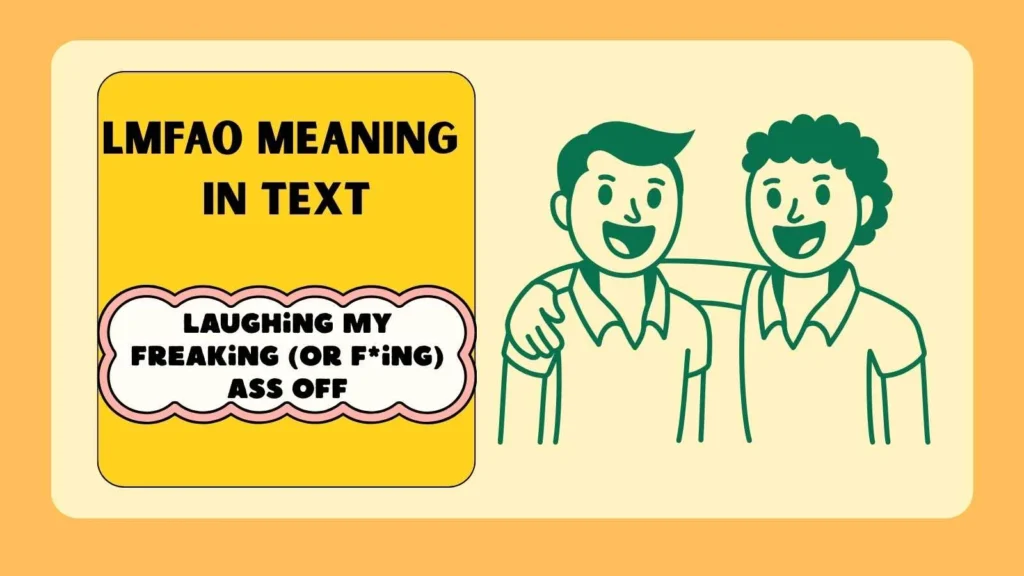Last updated on October 1st, 2025 at 09:12 am
If you’ve ever scrolled through a text message, group chat, or social media feed and spotted the acronym LMFAO, you’re not alone. This playful shorthand is one of the most popular ways people express uncontrollable laughter in the digital world.
In a space where speed and humor dominate conversations, LMFAO has become a go-to reaction that instantly tells others you’re cracking up. From casual texting to memes and viral tweets, it pops up everywhere—but not everyone knows its exact meaning, origins, or how to use it appropriately.
This guide breaks down LMFAO meaning in text, explores its background, explains when and where to use it, and even covers its suitability for professional communication.
Whether you’re a social media enthusiast or just curious about digital slang, you’ll leave this article ready to laugh—and text—like a pro.
Definition & Meaning
LMFAO stands for “Laughing My Freaking (or F*ing) Ass Off”**, and it’s used to express extreme amusement. When a simple “LOL” (Laughing Out Loud) doesn’t capture how funny something is, LMFAO steps in to show you’re laughing hysterically—virtually rolling on the floor.
The inclusion of a strong word (“freaking” or the explicit alternative) emphasizes the intensity of the laughter. It’s an escalation from LOL and LMAO, giving your reaction a bigger punch in casual conversations.
Background & History
The term originated in early internet chatrooms and instant messaging platforms during the late 1990s and early 2000s. As people sought quicker ways to express strong emotions online, abbreviations like LOL (Laugh Out Loud) and ROFL (Rolling On the Floor Laughing) gained popularity.
LMFAO emerged as a humorous upgrade, combining the intensity of laughter with playful exaggeration. Its widespread adoption was fueled by early social networks like MySpace, AIM, and later Twitter and Facebook, cementing it as a staple of online humor.
Usage in Various Contexts
LMFAO can appear in countless scenarios—from texting friends about a hilarious meme to reacting to awkward social blunders. People often use it when words fail to capture how funny something is, whether in a casual group chat, gaming lobby, or comment thread.
On platforms like TikTok, Instagram, and Twitter, LMFAO serves as a quick, relatable response to viral videos or jokes. While it’s mostly lighthearted, context matters: it’s informal and best suited for personal or social interactions, not serious or professional conversations.
Common Misconceptions & Clarifications
Many assume LMFAO always includes an offensive word, but “freaking” is a widely accepted alternative that softens the meaning.
Others mistakenly think it stands for something unrelated to laughter. Despite containing a potentially explicit letter, it’s rarely meant to be vulgar—it’s simply a stronger form of saying “I can’t stop laughing.”
Similar Terms & Alternatives
Other popular laugh-related abbreviations include:
- LOL – Laughing Out Loud
- LMAO – Laughing My Ass Off
- ROFL – Rolling On the Floor Laughing
- HAHA – Classic text-based laughter
- XD – A playful emoji-like face
Each carries its own tone, with LMFAO ranking among the strongest expressions of amusement.
How to Respond to This Term
When someone sends “LMFAO,” you can:
- Reply with your own laughter abbreviation (LOL, same energy).
- Add a laughing emoji 🤣 for emphasis.
- Share a funny follow-up or related joke.
The key is to keep the vibe light and humorous.
Regional or Cultural Differences
While LMFAO is understood globally, the explicit variation may be avoided in cultures with stricter language norms. Some regions prefer toned-down versions like LMAO or LOL, especially in more formal settings.
Comparison with Similar Terms
Compared to LOL or LMAO, LMFAO signals a much stronger reaction. If LOL is a polite chuckle, and LMAO is hearty laughter, LMFAO is uncontrollable, can’t-breathe laughter. It’s the digital equivalent of falling off your chair laughing.
Usage in Online Communities & Dating Apps
In online forums, gaming chats, and dating apps, LMFAO breaks the ice by adding humor to conversations. A well-timed LMFAO shows that you’re fun, easygoing, and engaged with the moment. Just avoid overusing it—it loses impact if every message ends with LMFAO.
Hidden or Offensive Meanings
While the “F” can stand for an explicit word, most users interpret it as harmless fun. Still, avoid using LMFAO in professional environments where explicit language might be flagged or misinterpreted.
Suitability for Professional Communication
LMFAO is not recommended in formal emails, work chats, or business presentations. If you need to express laughter in a professional setting, opt for neutral alternatives like “That’s hilarious!” or a simple “Haha.”
FAQs:
What does LMFAO stand for?
It means Laughing My Freaking/F*ing Ass Off**, expressing intense laughter.
Is LMFAO rude to use?
Not necessarily, but the “F” can be seen as explicit in some contexts.
Can LMFAO be used in professional texts?
No, it’s best reserved for informal chats and social media.
Is LMFAO stronger than LMAO?
Yes, LMFAO is a more intense version of LMAO.
Are there safe alternatives?
Yes, use LOL, LMAO, or HAHA for a milder effect.
When did LMFAO become popular?
It gained traction in the late 1990s and early 2000s with the rise of online messaging.
Conclusion:
From early internet chatrooms to today’s viral social media posts, LMFAO meaning in text continues to embody the fun, exaggerated laughter of the digital age. It’s a playful, high-energy way to react when “LOL” simply isn’t enough.
Whether you choose the explicit or family-friendly version, LMFAO remains a timeless reminder that humor connects people—even through screens.
